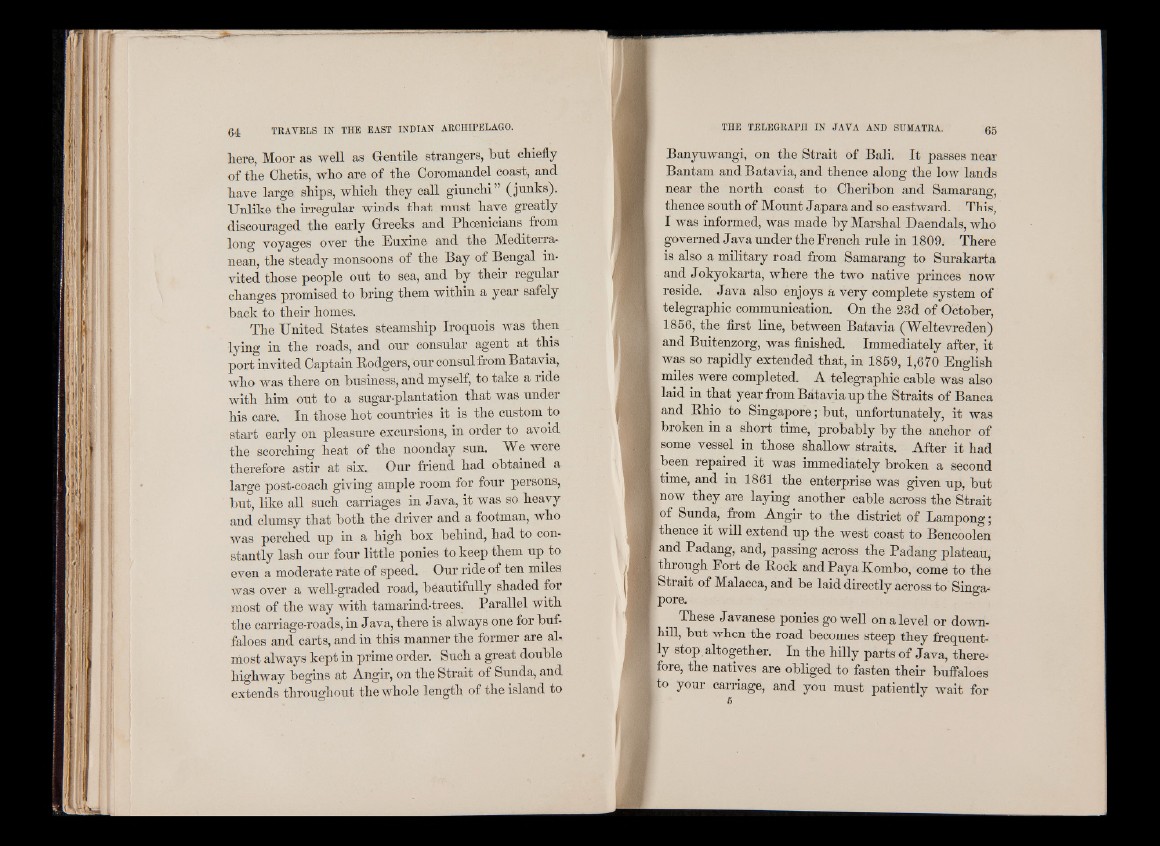
here, Moor as well as Gentile strangers, but chiefly
of the Chetis, who are of the Coromandel coast, and
have large ships, which they call giunchi” (junks).
Unlike the irregular winds that must have greatly
discouraged the early Greeks and Phoenicians from
long voyages over the Euxine and the Mediterranean,
the steady monsoons of the Bay of Bengal invited
those people out to sea, and by their regular
changes promised to bring them within a year safely
back to their homes.
The United States steamship Iroquois was then
l y in g in the roads, and our consular agent at this
port invited Captain Rodgers, our consul from Batavia,
who was there on business, and myself, to take a ride
with him out to a sugar-plantation that was under
his care. In those hot countries it is the custom to
start early on pleasure excursions, in order to avoid
the scorching heat of the noonday sun. We were
therefore astir at six. Our friend had obtained a
large post-coach giving ample room for four persons,
but, like all such carriages in Java, it was so heavy
and clumsy that both the driver and a footman, who
was perched up in a high box behind, had to constantly
lash our four little ponies to keep them up to
even a moderate rate of speed. Our ride of ten miles
was over a well-graded road, beautifully shaded for
most of the way with tamarind-trees. Parallel with
the carriage-roads, in Java, there is always one for buffaloes
and carts, and in this manner the former are almost
always kept in prime order. Such a great double
highway begins at Angir, on the Strait of Sunda, and
extends throughout the whole length of the island to
Banyuwangi, on the Strait of Bali. It passes near
Bantam and Batavia, and thence along the low lands
near the north coast to Cheribon and Samarang,
thence south of Mount Japara and so eastward. This,
I was informed, was made by Marshal Daendals, who
governed J ava under the French rule in 1809. There
is also a military road from Samarang to Surakarta
and Jokyokarta, where the two native princes now
reside. Java also enjoys a very complete system of
telegraphic communication. On the 23d of October,
1856, the first line, between Batavia (Weltevreden)
and Buitenzorg, was finished. Immediately after, it
was so rapidly extended that, in 1859, 1,670 English
miles were completed. A telegraphic cable was also
laid in that year from Batavia up the Straits of Banca
and Rhio to Singapore; but, unfortunately, it was
broken in a short time, probably by the anchor of
some vessel in those shallow straits. After it had
been repaired it was immediately broken a second
time, and in 1861 the enterprise was given up, but
now they are laying another cable across the Strait
of Sunda, from Angir to the district of Lampong;
thence it will extend up the west coast to Bencoolen
and Padang, and, passing across the Padang plateau,
through Fort de Rock and Pay a Kombo, come to the
[Strait of Malacca, and be laid directly across to Singapore.
These Javanese ponies go well on a level or downhill,
but when the road becomes steep they frequently
stop. altogether. In the hilly parts of Java, therefore,
the natives are obliged to fasten their buffaloes
to your carriage, and you must patiently wait for
5